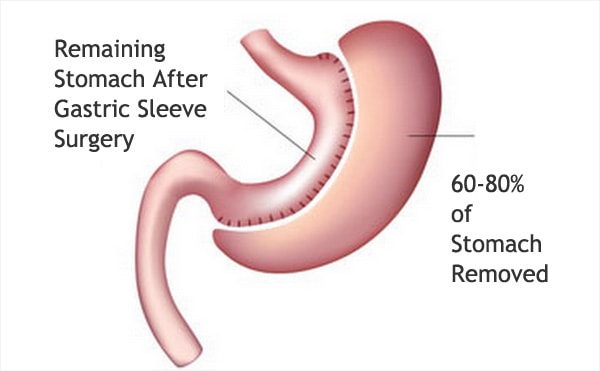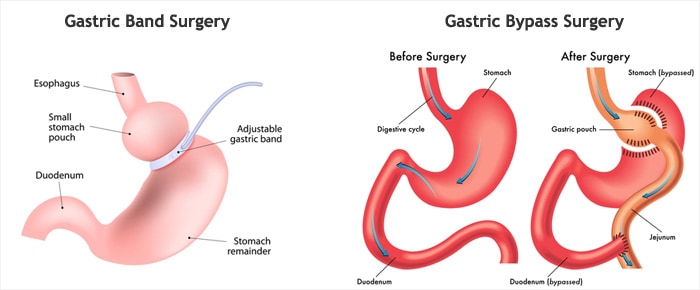Gastric Sleeve Surgery
Gastric sleeve surgery, also known as sleeve gastrectomy, is a growing trend among obese patients who are unable to lose weight in a traditional way. It involves the removal of around 60 - 80 % of the stomach, creating a long sleeve shaped stomach that has a reduced ability to hold large amounts of food.
 Gastric Sleeve Surgery is the fastest growing bariatric surgery procedure between 2010 - 2015
Gastric Sleeve Surgery is the fastest growing bariatric surgery procedure between 2010 - 2015
Gastric sleeve surgery is often used as an interim solution to patients with a very high BMI over 50, in order to get them to a suitable weight for more complicated weight loss surgeries. It’s preferred for those with a very high BMI because it has a much lower rate of complication due to surgery, and has a much faster recovery. This is because unlike other surgeries to improve weight loss in obese patients, it does not change the order or function of the digestive system, and does not introduce any foreign items into the body the way gastric band surgery and gastric bypass surgery does.
Its purpose is purely restrictive, reducing the risk of malnutrition, and dumping syndrome (where the body tries to rapidly expel sugary and fatty foods through diarrhoea and/ or vomiting.
A full psychological testing is undertaken before the surgery to determine the suitability of the patient. While it’s important for those who have extremely high BMI’s to lose the weight, the change in diet is extreme and can be very confronting.
Procedure Description
To perform a sleeve gastrectomy, surgeons create a thin sleeve using a stapling device. The sleeve is similar in size and shape to a banana. Once the stapling process is completed, the rest of the stomach is removed.
By reducing the size of the stomach in this way, sleeve gastrectomy surgery reduces the amount of food that can be consumed in one sitting. Those who undertake the surgery feel full with much smaller meals, and stay full for a much longer period of time.
By eating less food your body stores less excess calories, and starts to burn excess fat.
Perhaps one of the most significant things about sleeve gastrectomy surgery is that it doesn't change the normal digestion of the body. Food passes though the stomach in same way is it did before surgery, allowing for the proper absorption of nutrients.
Comparison to Other Surgery

The Lap Band Surgery, which involves the insertion of a restricting silicone ring around the stomach, which can be made smaller or bigger with the addition or removal of saline through a port which resides under the skin. It essentially performs the same job as a gastric sleeve surgery, reducing the size of the stomach, however, unlike the gastric sleeve surgery the lap band surgery is reversible.
Gastric Bypass Surgery involves surgeon attaching a portion of the small intestine directly into a smaller modified stomach pouch. This allows food to bypass a large portion of the small intestine, and significantly reduces the size of the stomach and allows the patient to feel fuller more quickly. This surgery changes the pathway of food through the digestive system, and can lead to digestive complications because of this.
Recovery from the surgery occurs relatively quickly. Patients generally stay in hospital for around two days. They are able to eat no fat, no sugar foods, in liquid form. Some nausea and vomiting may still occur but this generally disappears by six months.
Am I a Candidate for Gastric Sleeve Surgery?
Not all overweight people will be eligible to access gastric sleeve surgery. In order to be a good candidate for the procedure, you must be classified as morbidly obese (a BMI of 40 or higher), unless you have an obesity related disease such as diabetes, sleep apnea, joint problems or asthma, in which case, a BMI of 35 is acceptable.
Your body must be able to cope with a surgical procedure. If you have health issues stemming from being overweight, they may be mitigated by a small amount of weight loss to be done before surgery.
The two other vital components of a good candidate for gastric sleeve surgery are physical and psychological readiness. After surgery huge changes are necessary in diet, exercise and attitude. Assessments are made of potential candidates to ensure their suitability in these two areas.
 Gastric Sleeve Surgery: Before and after pictures
Gastric Sleeve Surgery: Before and after pictures
Advantages
- Patients who successfully undergo Gastric sleeve surgery can expect to have around a 50% weight loss. The average maintenance weight for these patients is also around 50%.
- There is a very low incidence of vitamin and mineral deficiency as the natural path of the digestive tract is preserved.
- There is less risk of digestive malfunction as the entry and exit to the stomach are kept in tact, and the nerves in the stomach are preserved.
- There are fewer doctors visits than with other weight loss surgeries.
- Does not re-route intestines
Disadvantages
- One of the potential side effects is that the site of the surgery leaks. Statistical evidence suggests that experienced surgeon who are working in hospitals that perform a high number of gastric sleeve operations have a much lower rate of complications than those doctors who are performing the surgeries less often. The rapid weight loss (brought on by any type of gastric surgery) can also cause the onset of gallstones. It’s for this reason that some surgeons take out the gall bladder at the same time as performing the surgery.
- With an average cost of $17,000 in the USA, gastric sleeve surgery is not an inexpensive undertaking. It’s important to make sure you understand all the related cost of the surgery which may not be included in the quoted price, including, stays in the hospital, the anesthetist, post-operative visits, and medications.